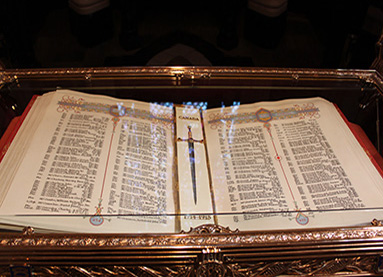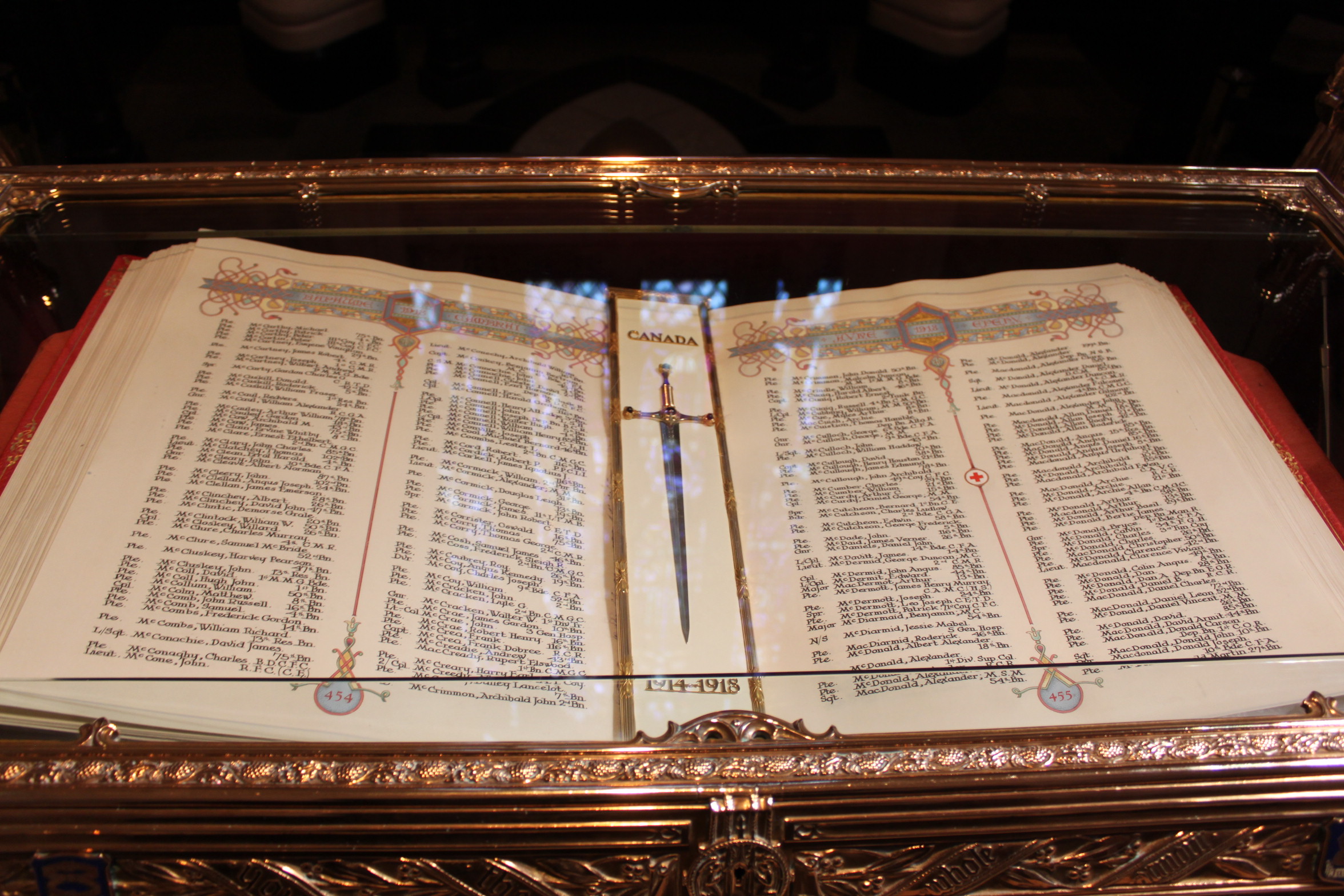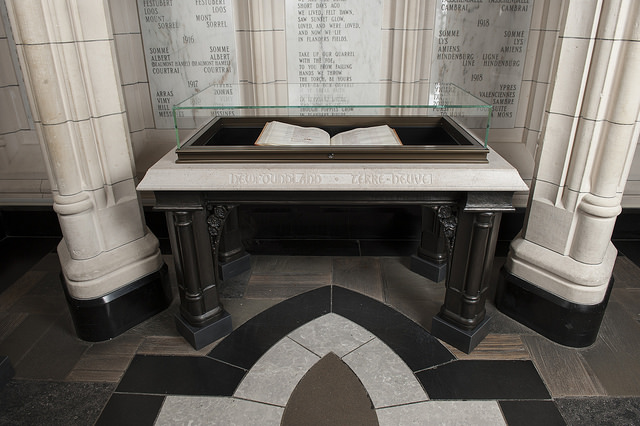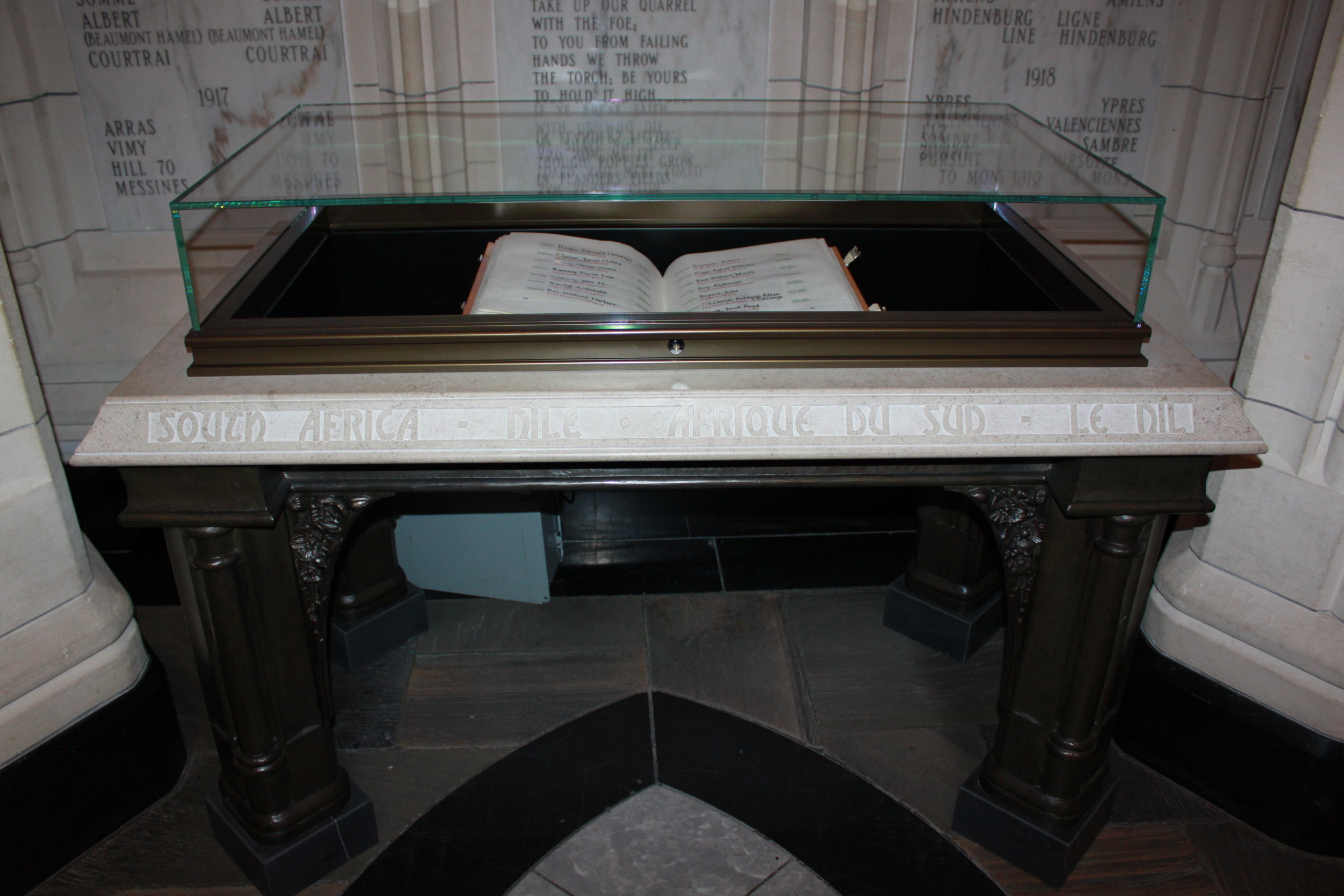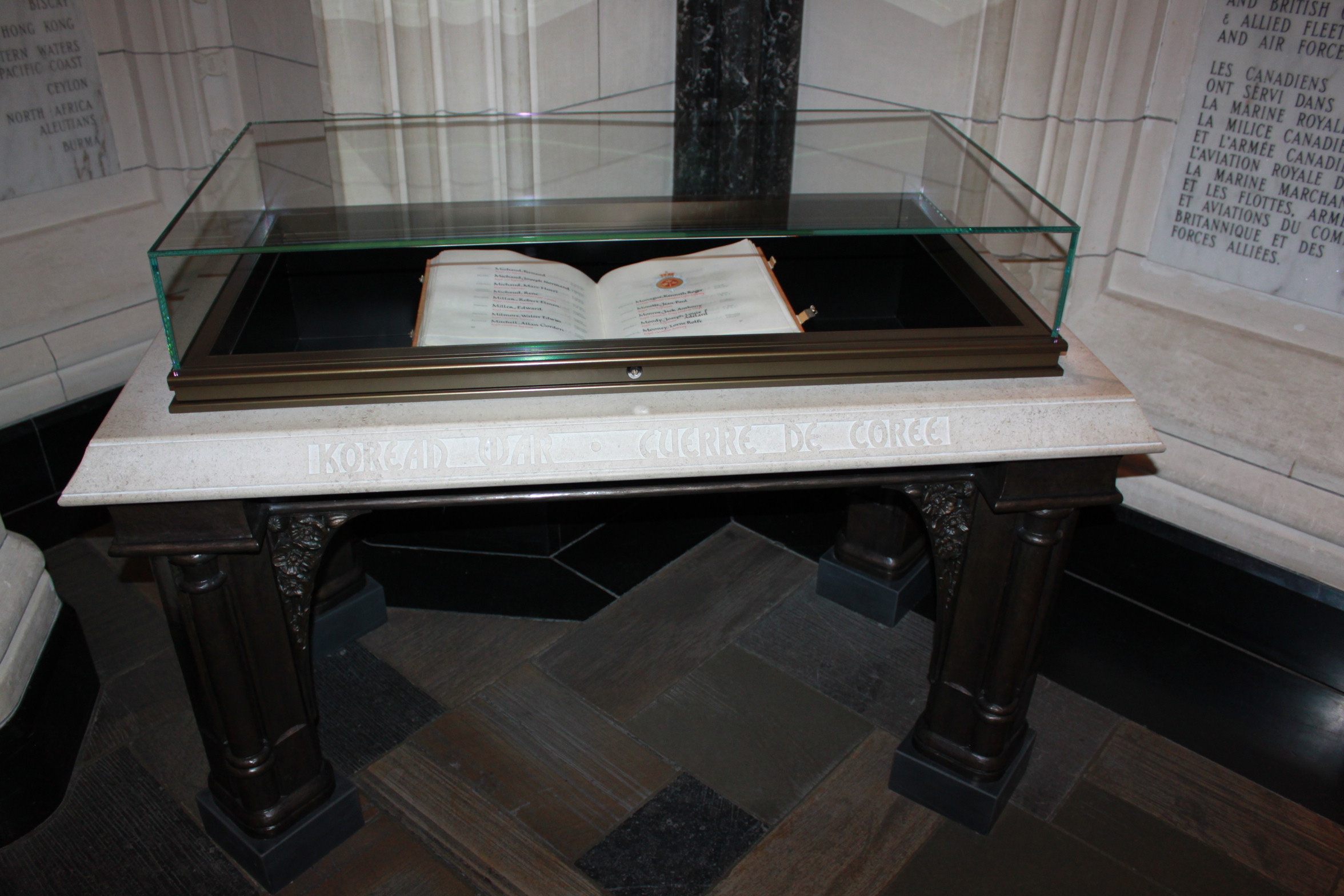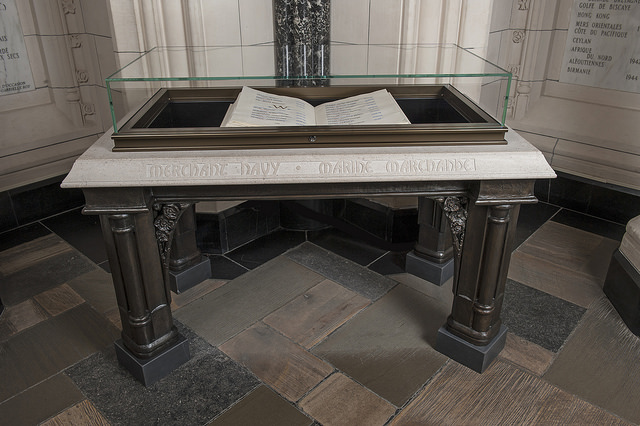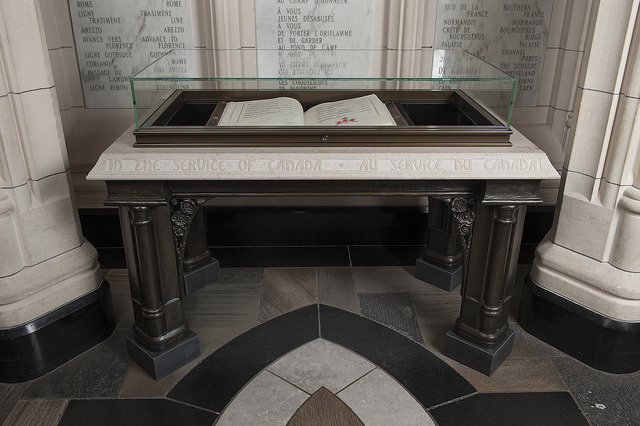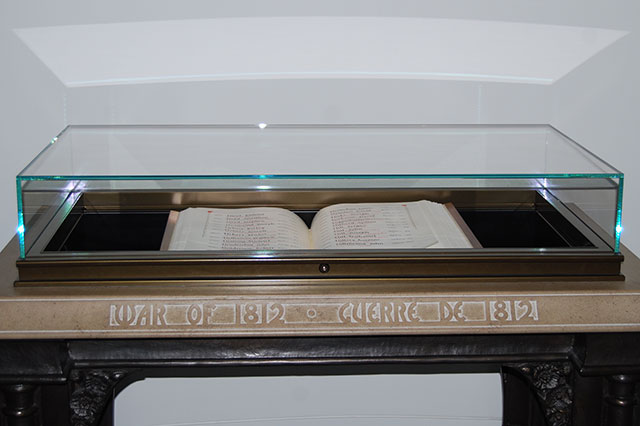History of the Books of Remembrance
Table of Contents
Introduction
The eight Books of Remembrance traditionally lie in the Memorial Chamber in the Peace Tower on Parliament Hill. Together, they commemorate the more than 120,000 Canadians who gave their life while serving in uniform.
Peace Tower and the Books of Remembrance
On 1 July 1917, Prime Minister Sir Robert Borden dedicated a site in the Centre Block of the Houses of Parliament, calling the new structure a "memorial to the debt of our forefathers and to the valour of those Canadians who, in the Great War, fought for the liberties of Canada, of the Empire, and of humanity."
The stone used to build the Memorial Chamber was gifted to Canada by Belgium, France, and England. The initial plan was to engrave the names of Canadians who died during the First World War on the walls of the Memorial Chamber. As the lists of those lost were received, it became clear there would not be enough space on the walls for all of the names. The idea of a Book of Remembrance was developed as an alternative.
On 1 September 1919, the Prince of Wales laid the corner stone of "The Tower of Victory and Peace", known today as the Peace Tower. The tower was inaugurated on 1 July 1927.
First World War Book of Remembrance
The concept of a Book of Remembrance is credited to Colonel Archer Fortescue Duguid, DSO, a Veteran of the First World War. The plan was accepted and minor alterations were made to the Memorial Chamber to accommodate the Book.
On 3 August 1927, the Prince of Wales returned to Canada to unveil the altar—a gift from the British Government—where the First World War Book of Remembrance would rest.
James Purves, from London, Ontario, was chosen to create the First World War Book of Remembrance. It was expected that the Book would take five years to complete at a cost of $35,000.
James Purves died in 1940, before the Book was finished. Following Purves’ death his assistant Alan Beddoe, an artist from Ottawa, continued the work. William Henry Baldwin, DFC, of Ottawa, inscribed the names of the fallen. Baldwin himself would be killed in the Second World War and is commemorated on page 133 of the Second Word War Book of Remembrance.
The First World War Book of Remembrance was dedicated on 11 November 1942. The first and largest of the Books of Remembrance, it contains more than 66,000 names, with roughly 125 names per page. The original Book was ten inches thick and weighed sixty-eight pounds. It was rebound into two volumes in 1959, when the original binding was replaced.
Second World War Book of Remembrance
In 1948, it was decided that a Book of Remembrance would be created to commemorate the Canadians who lost their lives in the Second World War.
Allan Beddoe was again selected as the artist. After being chosen, Beddoe wrote:
"… I am most anxious to produce a work that will be a fitting tribute to those who died, but further still to create something that may be regarded as one of the great works of its kind in modern times. This demands art, and while I am fully attentive to the fact that this project is being paid for out of public funds and should therefore be kept within reasonable costs, I am nevertheless equally conscious of my responsibility as an artist to the people of Canada in that they will expect something exceptionally fine for the money spent."
Work was scheduled to be completed by August 1952, however, issues with materials, service record verification, along with improper working conditions all slowed its completion.
Writing and illustrating for the Book began in the fall of 1949 but problems continued. The format for the inscriptions was changed after nearly half of the names were already entered. Completed names were discarded and the work started again.
The Second World War Book of Remembrance was finally placed in the Memorial Chamber on Remembrance Day 1957.
It contains the names of more than 44,000 Canadians who died during the Second World War. Approximately 75 names appear on each per page, across multiple volumes. Beddoe also included pages commemorating battles and places significant to Canadians during the war.
Newfoundland Book of Remembrance
The Newfoundland Book of Remembrance commemorates those Newfoundlanders who gave their lives during the First and Second World Wars—before Newfoundland joined Confederation on 1 April 1949. Those listed are from all three branches of the military—the Navy, Air Force and Army. The Book includes memorials of First World War campaigns such as Gallipoli and Beaumont-Hamel and Second World War campaigns, like North Africa, Italy, and Northwest Europe. It contains more than 2,300 names and was installed in the Memorial Chamber in 1973. A replica was also placed in the Confederation Building in St. John's.
South African War / Nile Expedition Book of Remembrance
The South African War / Nile Expedition Book of Remembrance commemorates Canadians who died during the South African War (1899—1902) and the Nile Expedition (1884—1885).
The Nile Expedition in 1884 was Canada’s first participation in a war overseas. Four hundred volunteers served in the expedition and sixteen were killed.
The South African War began on 11 October 1899. It was the first time large groups of Canadian troops served abroad. More than 7,000 Canadians volunteered to fight in the South African War.
Almost 300 names are listed in the South African War / Nile Expedition Book of Remembrance. The Book was dedicated and placed in the Memorial Chamber on 31 May 1962, on the 60th anniversary of the signing of the Treaty of Vereeniging, which ended the South African War.
Korean War Book of Remembrance
The Korean War Book of Remembrance commemorates the Canadians who died during the Korean War (1950—1953).
On 25 June 1950, North Korean forces crossed the 38th Parallel into the Republic of Korea. This marked the beginning of three years of fighting throughout the Korean Peninsula. During the conflict, 516 Canadians were killed. Their names are inscribed in the Korean War Book of Remembrance, which includes a page decorated with the United Nations symbol surrounded by the Arms of the 17 countries which joined the United Nations Forces.
The Book was dedicated in the Memorial Chamber on 11 November 1962 by Governor-General, Major General Georges Vanier, DSO, MC, CD.
Merchant Navy Book of Remembrance
The Merchant Navy Book of Remembrance commemorates members of the Merchant Marine who gave their lives serving Canada at sea, during the First and Second World Wars. The Book also includes poetry, maps and ocean-related images.
During the First World War, merchant ships were targeted by enemy surface raiders to cut off supplies and personnel from reaching Europe. By April 1915, 54 Allied merchant ships had been sunk and by 1917, 1,220 were destroyed. There is no record of the number of merchant mariners who served on the high seas during the Great War, but it is known that more than 570 of them died.
In August 1939, the Royal Canadian Navy took control of all merchant ships. Merchant mariners were not required to serve, but roughly 12,000 of them did. More than 1,600 members of the Canadian Merchant Navy were killed in action during the Second World War.
The Merchant Navy Book of Remembrance was dedicated in 1993.
In the Service of Canada Book of Remembrance
In the Service of Canada Book of Remembrance lists the names more than 1,900 members of the Canadian Armed Forces who have died while serving Canada since 1 October 1947, excluding those who are commemorated in the Korean War Book of Remembrance. This includes those who died in conflict, peacetime training exercises, deployments abroad or other military duty.
The Book begins with the date of October 1, 1947, the day after eligibility for entry in the Second World War Book of Remembrance closed.
The In the Service of Canada Book of Remembrance was dedicated on 11 November 2005. As Volume I is almost full, a second volume was created which contains names from 2015 onward.
War of 1812 Book of Remembrance
The War of 1812 Book of Remembrance commemorates over 1,600 individuals who were killed while serving Canada as a colony of Great Britain. The Book includes a section dedicated to Indigenous Peoples who played a pivotal role in this war.
The eighth Book of Remembrance was commissioned in 2012 to mark the 200th anniversary of the signing of a peace treaty that ended the War of 1812. On 5 February 2019, the War of 1812 Book of Remembrance was officially unveiled in the Room of Remembrance of the Visitor Welcome Centre on Parliament Hill.
Memorial Chamber / Room of Remembrance
Canada's Books of Remembrance are normally housed in the Memorial Chamber on the second level of the Peace Tower on Parliament Hill.
In February 2019, the Memorial Chamber was closed for the decade-long Centre Block renovation project and the eight Books of Remembrance were moved into the Room of Remembrance. The Room of Remembrance serves as a quiet, solemn space, where individuals can visit the Books and honour those who have given their lives while serving our country.
- Date modified:
